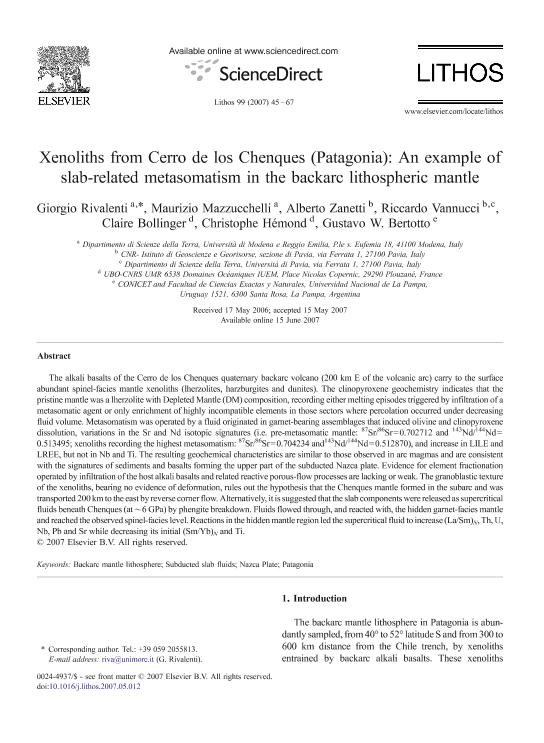Artículo
Xenoliths from Cerro de los Chenques (Patagonia): An example of slab-related metasomatism in the backarc lithospheric mantle
Rivalenti, Giorgio; Mazzucchelli, Maurizio; Zanetti, Alberto; Vannucci, Riccardo; Bollinger, Claire; Hémond, Christophe; Bertotto, Gustavo Walter

Fecha de publicación:
11/2007
Editorial:
Elsevier Science
Revista:
Lithos
ISSN:
0024-4937
Idioma:
Inglés
Tipo de recurso:
Artículo publicado
Clasificación temática:
Resumen
The alkali basalts of the Cerro de los Chenques quaternary backarc volcano (200 km E of the volcanic arc) carry to the surface abundant spinel-facies mantle xenoliths (lherzolites, harzburgites and dunites). The clinopyroxene geochemistry indicates that the pristine mantle was a lherzolite with Depleted Mantle (DM) composition, recording either melting episodes triggered by infiltration of a metasomatic agent or only enrichment of highly incompatible elements in those sectors where percolation occurred under decreasing fluid volume. Metasomatism was operated by a fluid originated in garnet-bearing assemblages that induced olivine and clinopyroxene dissolution, variations in the Sr and Nd isotopic signatures (i.e. pre-metasomatic mantle: 87Sr/86Sr = 0.702712 and 143Nd/144Nd = 0.513495; xenoliths recording the highest metasomatism: 87Sr/86Sr = 0.704234 and143Nd/144Nd = 0.512870), and increase in LILE and LREE, but not in Nb and Ti. The resulting geochemical characteristics are similar to those observed in arc magmas and are consistent with the signatures of sediments and basalts forming the upper part of the subducted Nazca plate. Evidence for element fractionation operated by infiltration of the host alkali basalts and related reactive porous-flow processes are lacking or weak. The granoblastic texture of the xenoliths, bearing no evidence of deformation, rules out the hypothesis that the Chenques mantle formed in the subarc and was transported 200 km to the east by reverse corner flow. Alternatively, it is suggested that the slab components were released as supercritical fluids beneath Chenques (at ∼ 6 GPa) by phengite breakdown. Fluids flowed through, and reacted with, the hidden garnet-facies mantle and reached the observed spinel-facies level. Reactions in the hidden mantle region led the supercritical fluid to increase (La/Sm)N, Th, U, Nb, Pb and Sr while decreasing its initial (Sm/Yb)N and Ti.
Palabras clave:
Backarc Mantle Lithosphere
,
Nazca Plate
,
Patagonia
,
Subducted Slab Fluids
Archivos asociados
Licencia
Identificadores
Colecciones
Articulos(INCITAP)
Articulos de INST.D/CS D/L/TIERRA Y AMBIENTALES D/L/PAMPA
Articulos de INST.D/CS D/L/TIERRA Y AMBIENTALES D/L/PAMPA
Citación
Rivalenti, Giorgio; Mazzucchelli, Maurizio; Zanetti, Alberto; Vannucci, Riccardo; Bollinger, Claire; et al.; Xenoliths from Cerro de los Chenques (Patagonia): An example of slab-related metasomatism in the backarc lithospheric mantle; Elsevier Science; Lithos; 99; 1-2; 11-2007; 45-67
Compartir
Altmétricas



